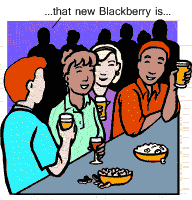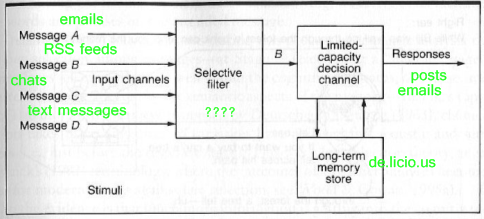Definition
The cocktail party effect describes the ability to focus one's listening attention on a single talker among a mixture of conversatio.
The cocktail party effect describes the ability to focus one's listening attention on a single talker among a mixture of conversatio.
| the difficulty of focusing one's attention on a single auditory source within a jumble of noises; the process of selective listening | |
| Example: | In a room where several conversations are taking place, one can focus on one of them and ignore the rest: the cocktail party effect. http://en.wikipedia.org/wiki/Source_separation http://en.wikipedia.org/wiki/Cocktail_party_effect http://www.spring.org.uk/2009/03/the-cocktail-party-effect.php http://xenia.media.mit.edu/~barons/html/cocktail.html http://www.vislab.uq.edu.au/education/sc3/2001/johan/johan.pdf http://www.hear-it.org/-The-cocktail-party-effect-How-the-brain-filters-noise http://ask.reference.com/web?q=What%20Is%20The%20Cocktail%20Party%20Effect?&o=100100 http://dictionary.reference.com/browse/cocktail+party+effect http://www.google.co.in/imgres?imgurl=http://www.scientificamerican.com/media/inline/solving-the-cocktail-party-problem_1.jpg&imgrefurl=http://www.scientificamerican.com/article.cfm?id%3Dsolving-the-cocktail-party-problem&h=277&w=277&sz=24&tbnid=8muWlbzkszZqLM:&tbnh=90&tbnw=90&zoom=1&usg=__bLh7WXcwQuu5dUEpesKwk8stzBU=&docid=Rv5HEND87n4-bM&sa=X&ei=GpfJUNPkC4mXiAfGgoHQDg&ved=0CF4Q9QEwBg&dur=4636 https://www.google.co.in/search?q=cocktail+party+problem&rlz=1C1IRFF_enIN511IN511&oq=cocktail+party+problem&aqs=chrome.0.57j59l2j60l2.6388343&sugexp=chrome,mod=17&sourceid=chrome&ie=UTF-8 http://www.comp.lancs.ac.uk/~kristof/research/papers/phd/2003/index.html http://www.scientificamerican.com/article.cfm?id=solving-the-cocktail-party-problem http://www.cns.nyu.edu/~jhm/mcdermott_CB_cocktail.pdf cock tail http://cnl.salk.edu/~tewon/Blind/blind_audio.html http://wanderingstan.com/2006-12-17/the_cocktail_party_effect http://www.toptenz.net/top-10-strange-examples-of-cognitive-phenomenon.php http://www.toptenz.net/top-10-strange-examples-of-cognitive-phenomenon.php/cocktail-party-effect The Cocktail Party Effect You’re at a crowded holiday cocktail party and engaged in conversation about politics. Oh, first a little backstory: For the last week you’ve been thinking of buying the new Blackberry phone. Back at the party, you suddenly realize that the people behind you are talking about Blackberries. Involuntarily, your attention shifts to that conversation. You’re at a crowded holiday cocktail party and engaged in conversation about politics. Oh, first a little backstory: For the last week you’ve been thinking of buying the new Blackberry phone. Back at the party, you suddenly realize that the people behind you are talking about Blackberries. Involuntarily, your attention shifts to that conversation.What does this have to do with the web? It’s the problem of information overload again. Before your attention shifted, you were able to concentrate on your conversation even though your ears were recieving input from all the other conversations. This magic is known as the cocktail party effect. Most scientists focus their research on how this is possible, but I’m more fascinated by the shifts in attention that comes when something “interesting” is said in a non-attended conversation. This is a great example of your brain manages limited attention resources. Two immediate corrolarys to the web:
I’ll leave you with Broadbent’s “Filter Theory of Selective Attention”. (The most basic model proposed for how the Cocktail Effect is accomplished in the brain.)  …could be re-imagined as:  Blind Source Separation of recorded speech and music signals.
We present methods to separate blindly mixed signals recorded in a room. The learning algorithm is based on the information maximization in a single layer neural network. We focus on the implementation of the learning algorithm and on issues that arise when separating speakers in room recordings. We used an infomax approach in a feedforward neural network implemented in the frequency domain using the polynomial filter matrix algebra technique. Fast convergence speed was achieved by using a time-delayed decorrelation method as a preprocessing step. Under minimum-phase mixing conditions this preprocessing step was sufficient for the separation of signals. These methods successfully separated a recorded voice with music in the background (cocktail party problem).
Blind Source Separation: Audio ExamplesThe audio-files have been updated with the new proposed algorithm combining TDD - algorithm and ICA (see ICASSP'98 paper).1. Speech - Music SeparationA speaker has been recorded with two distance talking microphones (sampling rate 16kHz) in a normal office room with loud music in the background. The distance between the speaker, cassette player and the microphones is about 60cm in a square ordering. (All files are in 16kHz wav-format).2. Speech - Speech SeparationA real Cocktail Party Effect . Two Speakers have been recorded speaking simultaneously. Speaker 1 says the digits from one to ten in English and speaker 2 counts at at the same time the digits in Spanish (uno dos ... ) The recording has been done in a normal office room. The distance between the speakers and the microphones is about 60cm in a square ordering (sampling rate 16kHz). (All files are in 16kHz wav-format). 3. Speech - Speech Separation in difficult environmentsA real Cocktail Party Effect II . Two Speakers have been recorded speaking simultaneously. This time the recording was in a conference room ( 5.5m by 8m ). The conference room had some air-conditioning noise. Both speakers are reading a section from the newspaper for 16sec. The mics were placed 120 cm away from the speakers. (sampling rate 16kHz). (All files are in 16kHz wav-format). The unmixing filters need to be sufficiently long. We used a filter size of 2048 taps for each filter. ICA PCA sourse seperation http://music.cs.northwestern.edu/research.php http://www.memories-project.eu/features.html http://www.egr.msu.edu/bsr/intro.html Non linear Source Separationhttp://www.slideworld.org/patient/slideshow.aspx/BP-Targets-lt140/viewslides.aspx/Independent-Component-Analysis--Blind-Source-Separation-ppt-31375The cocktail party effect: How the brain filters noiseThe brain filters noise. This is called the cocktail party effect
Left side of brain sorts out the soundsBrain researchers have investigated what happens in the brain when discriminating between the sounds we listen for and other noise. The study was headed by Hideko Okamoto of the University of Münster, Germany. He and his team exposed a number of individuals to test sounds and background noise in one or both ears while monitoring their brain activity. The recorded brain activity indicated greater activity in the left half of the brain when discriminating sounds from noise. In other words, the cocktail party effect occurs in the left side of the brain.As of yet, the researchers are unable to determine why hearing impaired people’s ability to discriminate sounds from noise is diminished and reduce the cocktail party effect. This is a matter for future research. Knowledge about the brain functions including the cocktail party effect will eventually benefit hearing impaired people in terms of the development of new treatment methods and assistive devices and help them to keep the cocktail party effect. Source: BMC Biology |







Thanks a lot for sharing this amazing knowledge with us. This site is fantastic. I always find great knowledge from it. Selective Attention Test Examples
ReplyDelete